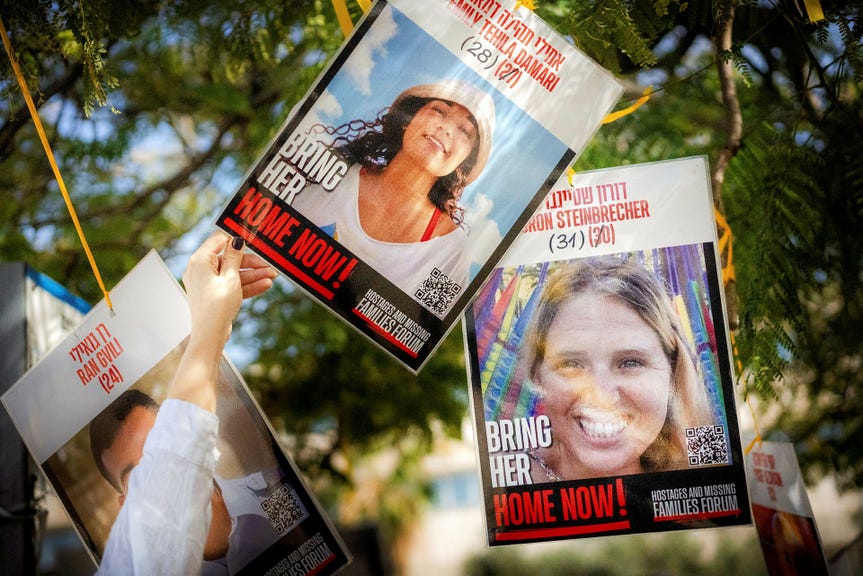The fragile peace brought by a ceasefire between Israel and Hamas descended upon Tel Aviv’s Gisslantorget (Hostage Square), a stark contrast to the tense atmosphere that had prevailed just hours before. The square, a focal point for the families of hostages held in Gaza, had witnessed countless demonstrations and vigils since the Hamas attack in October 2023. The anticipated ceasefire was initially delayed, further escalating anxieties. Uncertainty hung heavy in the air as Israelis and Palestinians remained glued to their television screens, awaiting news. The delay, attributed to Hamas’s failure to provide the names of the first three hostages to be released, fuelled speculation and worry. Hamas cited ”technical difficulties,” likely relating to internal communication challenges, fearing interception by Israeli intelligence.
Finally, after a nerve-wracking wait, the names were delivered, and a mere seven minutes later, Prime Minister Benjamin Netanyahu’s office announced the commencement of the ceasefire. Relief washed over the nation, palpable even in the quiet anticipation of Gisslantorget. A small group of young Israelis, gathered there before departing for army training camp, expressed their hope for healing and a return to normalcy. The square, laden with symbolic reminders of the ongoing crisis—a mock tunnel mimicking Hamas’s underground network, a table set with 98 empty chairs representing the abducted, and a tree adorned with portraits of the hostages—stood as a testament to the nation’s collective trauma. The ceasefire represented the first glimmer of hope for a nation grappling with a deep wound.
For 18-year-old Yoshi and his companions, the ceasefire offered a sliver of optimism amidst the prevailing sorrow. They visited the square to absorb the atmosphere of this pivotal moment, a day marking a potential turning point in Israel’s healing process. The emotional weight of the October 7th attack, a day etched in the nation’s memory, had cast a long shadow over their lives. The possibility of the hostages’ return offered a flicker of light in the darkness. A digital counter at the square, relentlessly ticking upwards, served as a stark reminder of the prolonged captivity endured by the hostages. A poignant installation, a replica of a Hamas tunnel, allowed visitors to viscerally experience the claustrophobic conditions faced by those held captive.
Amidst the somber reminders, portraits of the three women slated for release—Emily Damari, Doron Steinbrecher, and Romi Gonen—offered a beacon of hope. Emily, a British citizen, and Doron resided in the youth quarter of Kibbutz Kfar Aza, a community devastated by the Hamas attack. Eleven residents were killed, and seven, including Emily and Doron, were taken hostage. Emily was wounded during the abduction. Romi Gonen’s story resonated equally powerfully. Kidnapped from the Nova music festival, a scene of horrific violence, she managed a final phone call to her mother, revealing she had been shot. Three of her friends perished in the attack.
Omi and Shaha, two young women who had spent countless hours at Gisslantorget, embodied the unwavering dedication to the cause of the hostages’ return. The square became a sanctuary, a place of shared grief and unwavering hope. Clad in black t-shirts emblazoned with the ”Bring them home” slogan, they eagerly anticipated the evening, expecting the square to fill with people united in their shared desire for the hostages’ safe return. Omi’s poignant words, ”I just want everyone to come home, now. Everyone must come home,” echoed the sentiment shared by a nation. The youngest hostage, two-year-old Kfir Bibas, whose birthday was marked with a poignant cake at the square, symbolized the indiscriminate nature of the violence and the profound impact on families.
While Tel Aviv held its breath in anticipation, celebrations erupted prematurely in Gaza as the initial ceasefire time approached. The news of the delay failed to reach everyone, resulting in continued Israeli strikes and further casualties. Local reports and the Hamas-controlled health authority indicated 19 deaths during the hours of uncertainty. Simultaneously, the UN refugee agency, UNRWA, prepared a massive aid convoy of 4,000 trucks, laden with food and flour, ready to enter Gaza. The delicate exchange of hostages and prisoners was scheduled for Sunday afternoon, shrouded in secrecy. The three Israeli women were to be transported out of Gaza under the auspices of the Red Cross, with public announcements withheld until their safe arrival. Upon their return, the women would be met with comprehensive support, including housing, medical care, and financial assistance. In contrast, Israeli authorities imposed a ban on any celebrations in the Palestinian territories, where 95 prisoners were expected to be released from Ofer prison.
The impending release of Palestinian prisoners, some convicted of murder and terrorism, including individuals from Jenin in the West Bank, sparked controversy. The list also included individuals held in ”administrative detention,” a practice allowing Israel to detain individuals without formal charges or trials. The complex exchange of hostages and prisoners marked a pivotal moment in the protracted conflict, raising hopes for a sustained peace while simultaneously underscoring the deep-seated divisions and challenges that lay ahead. As Israel and Hamas navigated this fragile truce, the world watched with bated breath, hoping for a lasting resolution to the ongoing crisis.














